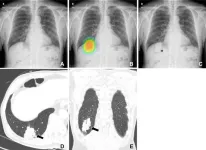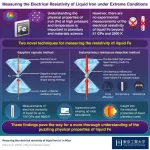(Press-News.org) A new study from Washington University School of Medicine in St. Louis suggests that growing up in poverty may influence the wiring of a child’s brain.
The study, published June 27 in JAMA Network Open, indicates a link between both neighborhood and household poverty and the brain’s white matter tracts, which allow for communication between brain regions. White matter plays a critical role in helping the brain process information.
The findings stem from the largest long-term study of brain development and child health conducted in the U.S. — the Adolescent Brain Cognitive Development (ABCD) Study, which was launched by the National Institutes of Health (NIH) in 2015. Washington University is a national leader in studies of the developing brain and is one of 21 study sites around the country participating in the ABCD Study, which is following nearly 12,000 children, beginning at ages 9 to 10, for at least a decade.
“White matter integrity is very important in brain development,” said first author Zhaolong (Adrian) Li, a neuroimaging research technician in the Department of Psychiatry. “For example, weaknesses in white matter are linked to visuospatial and mental health challenges in children. If we can capture how socioeconomic status affects white matter early on in a child’s life, the hope is we can, one day, translate these findings to preventive measures.”
The researchers also found that childhood obesity and lower cognitive function may explain, at least partially, poverty’s influence on white matter differences. Generally, children who grow up in poverty have a higher risk of obesity and score lower on tests of cognitive function than their peers in higher income neighborhoods and households. The latter could be due, in part, to limited access to enriching sensory, social and cognitive stimulation.
“Our finding that obesity and cognitive enrichment may be relevant mediators, if confirmed, would provide strong support for managing healthy weight and encouraging cognitively stimulating activities to support brain health in disadvantaged children,” said Tamara Hershey, PhD, the James S. McDonnell Professor of Cognitive Neuroscience and a professor of psychiatry and of radiology.
The research was conducted in the Neuroimaging Labs Research Center in the university’s Mallinckrodt Institute of Radiology.
White matter, the densely packed nerve fibers deep in the brain, gets its white color from the fatty substance that surrounds nerve fibers. The fatty coating is responsible for the rapid transmission of information along nerve cell tracts. The organization and connectivity between these tracts support learning and proper communication across brain regions. Disruption in these communication pathways has been linked to physical challenges as well as worse mental health outcomes.
The scientists used the publicly available ABCD Study database, through which they were able to model water movement as an indicator of white matter integrity in the brain scans of 8,842 children ages 9 to 11. Just like rocks, pebbles and boulders impact the flow of water in a river, diverse brain cell structures create barriers that hinder water diffusion. The researchers found less directional movement of water molecules in the brains of children living in poverty, signifying structural changes in white matter regions. They also found higher water content in spherical spaces in the brain, which hinted at possible neuroinflammation in children who live in poverty.
A child’s environment is complex, involving both neighborhood and family influences. Disadvantaged neighborhoods suffer disproportionately from unemployment, poverty, and income disparity. Single-parent homes are more common, and residents are typically less educated, earn a lower income, and own less property.
“Our analysis revealed that neighborhood poverty is linked to white matter differences and putative immune cell presence. We found a similar link when looking at household socioeconomic status, taking into account annual income and parental education,” Li said.
“Wealth and income inequality are accelerating in the U.S.,” said co-corresponding author Scott Marek, PhD, an assistant professor of radiology and of psychiatry. “We and others are starting to scratch the surface of how inequality may harm the developing brain and affect mental health outcomes. Our findings emphasize shifting away from the thinking that socioeconomics is a unitary construct. It’s not schools or parenting alone that matter for brain health. It’s likely the collection of many neighborhood and familial life factors.”
Hershey, who directs the Neuroimaging Labs Research Center and is a co-corresponding author, cautioned that the study only looked at one time point. Therefore, it is too soon to know if poverty triggered the brain differences seen in the study, she said. However, the ABCD Study continues to track enrolled children through brain scans and cognitive testing with the potential for future long-term brain development studies in disadvantaged children.
“We hope this work encourages future studies to examine modifiable health risk factors in large and longitudinal samples that would one day translate to intervention,” Hershey said.
END
Poverty negatively impacts structural wiring in children’s brains, study indicates
Reducing obesity, boosting cognitive enrichment may improve kids’ brain health
2023-06-27
ELSE PRESS RELEASES FROM THIS DATE:
BioOne extends partnership with the Entomological Society of America to preserve and disseminate entomological research spanning 100+ years
2023-06-27
WASHINGTON, D.C., June 27, 2023 – A trove of more than 160 eBooks in insect science is now available on the BioOne Digital Library, through an extension of BioOne’s partnership with the Entomological Society of America (ESA).
With the launch of the ESA eBook Collection, BioOne and ESA have partnered to source, digitize, and make fully searchable critical books from ESA’s catalog. Through this collaboration, BioOne and ESA share a commitment to make scientific research more accessible with the preservation of over 100 years ...
Human embryo-like models created from stem cells to understand earliest stages of human development
2023-06-27
Cambridge scientists have created a stem cell-derived model of the human embryo in the lab by reprogramming human stem cells. The breakthrough could help research into genetic disorders and in understanding why and how pregnancies fail.
Published today in the journal Nature, this embryo model is an organised three-dimensional structure derived from pluripotent stem cells that replicate some developmental processes that occur in early human embryos.
Use of such models allows experimental modelling ...
Study uncovers direct link between blood group a and a higher risk for COVID-19 infection
2023-06-27
(WASHINGTON, June 27, 2023) – Ask the average American what their blood type is, and you will likely receive a blank look. For most people, blood type only becomes an issue if they need a blood transfusion. Beginning in the earliest days of the COVID-19 pandemic, however, results from previous work published in Blood Advances suggested that people with blood group A (about a third of the US population) seemed to be more vulnerable to infection with the novel coronavirus, while those with blood group O (about 38% of the population) seemed to be somewhat less susceptible. Until now, however, ...
High accuracy AI improves lung cancer detection
2023-06-27
OAK BROOK, Ill. – Assistance from an artificial intelligence (AI) algorithm with high diagnostic accuracy improved radiologist performance in detecting lung cancers on chest X-rays and increased human acceptance of AI suggestions, according to a study published in Radiology, a journal of the Radiological Society of North America (RSNA).
While AI-based image diagnosis has advanced rapidly in the medical field, the factors affecting radiologists’ diagnostic determinations in AI-assisted image reading remain underexplored.
Researchers at Seoul National University looked at how these factors might influence the detection of malignant lung nodules during ...
Orangutans can make two sounds at the same time, similar to human beatboxing, study finds
2023-06-27
Orangutans can make two separate sounds simultaneously, much like songbirds or human beatboxers, according to a study led by the University of Warwick.
Academics say the findings provide clues around the evolution of human speech, as well as human beatboxing.
Scientists observed two populations of vocalising orangutans in Borneo and Sumatra across a total of 3800 hours and found primates within both groups used the same vocal phenomenon.
Dr Adriano Lameira, Associate Professor of Psychology at the University of Warwick said: “Humans use the lips, tongue, and jaw to make the unvoiced sounds ...
Beatboxing orangutans and the evolution of speech
2023-06-27
Orangutans can make two separate sounds simultaneously, much like songbirds or human beatboxers, according to a study. Adriano Lameira and Madeleine Hardus observed vocalizing orangutans in the wild. Humans use the lips, tongue, and jaw to make the unvoiced sounds of consonants, while activating the vocal folds in the larynx with exhaled air to make the voiced, open sounds of vowels. Orangutans are capable of producing both types of sounds—and both at once. For example, large male orangutans in Borneo will produce noises known as “chomps” in combination with “grumbles” in combative situations. Females in Sumatra produce “kiss squeaks” atop ...
What math can teach us about standing up to bullies
2023-06-27
In a time of income inequality and ruthless politics, people with outsized power or an unrelenting willingness to browbeat others often seem to come out ahead.
New research from Dartmouth, however, shows that being uncooperative can help people on the weaker side of the power dynamic achieve a more equal outcome—and even inflict some loss on their abusive counterpart.
The findings provide a tool based in game theory—the field of mathematics focused on optimizing competitive strategies—that could be applied to help equalize the balance of power in labor negotiations or international ...
Study identifies risk factors for early onset colorectal cancer in males
2023-06-27
INDIANAPOLIS – Colorectal cancer incidence and deaths are declining for individuals age 50 and older, but are increasing for those under 50.
A new study, led by researcher-clinician Thomas Imperiale, M.D., of the U.S. Department of Veterans Affairs, Regenstrief Institute and Indiana University School of Medicine, identifies seven risk factors for early onset colorectal cancer in males. The risk evaluation model the researchers developed may help 45- to 49-year-olds accept and adhere to new national screening recommendations and may also identify younger men for whom earlier screening should be considered.
“This study is important because ...
Air pollution speeds snowmelt
2023-06-27
Diminished anthropogenic pollutant emissions during 2020 Covid-19 lockdowns reduced snowmelt in the Himalayas, according to a study. Liqiang Zhang and colleagues used multiple satellite data from the Moderate Resolution Imaging Spectroradiometer (MODIS) and Ozone Monitoring Instrument (OMI), as well as a coupled atmosphere-chemistry-snow model (GEOS-Chem-SNICAR) to explore how the sudden, dramatic reduction in particulate pollution in the region affected snow and ice melt. Snow and ice on the Tibetan plateau act as a water source for over 20% of the global population. However, ice and snow in the Himalayas have been melting at an accelerating rate in recent decades. ...
Unveiling the secrets of liquid iron under extreme conditions
2023-06-27
Iron is the most abundant element by mass on Earth. Despite being so common and well-studied, iron still manages to puzzle scientists by exhibiting electric and magnetic behaviors that are not fully comprehensible. In particular, the physical properties of liquid iron—which makes up most of the Earth’s core—have been the subject of much debate among physicists and geoscientists.
The problem is that certain predictions about liquid iron’s properties are difficult to experimentally verify due to the extreme conditions required to ascertain them. For example, liquid iron’s resistivity, which is the inverse of electrical conductivity, has ...
LAST 30 PRESS RELEASES:
Global psychiatry mourns Professor Dan Stein, visionary who transformed mental health science across Africa and beyond
KIST develops eco-friendly palladium recovery technology to safeguard resource security
Statins significantly reduce mortality risk for adults with diabetes, regardless of cardiovascular risk
Brain immune cells may drive more damage in females than males with Alzheimer’s
Evidence-based recommendations empower clinicians to manage epilepsy in pregnancy
Fungus turns bark beetles’ defenses against them
There are new antivirals being tested for herpesviruses. Scientists now know how they work
CDI scientist, colleagues author review of global burden of fungus Candida auris
How does stroke influence speech comprehension?
B cells transiently unlock their plasticity, risking lymphoma development
Advanced AI dodel predicts spoken language outcomes in deaf children after cochlear implants
Multimodal imaging-based cerebral blood flow prediction model development in simulated microgravity
Accelerated streaming subgraph matching framework is faster, more robust, and scalable
Gestational diabetes rose every year in the US since 2016
OHSU researchers find breast cancer drug boosts leukemia treatment
Fear and medical misinformation regarding risk of progression or recurrence among patients with breast cancer
Glucagonlike peptide-1 receptor agonists and asthma risk in adolescents with obesity
Reviving dormant immunity: Millimeter waves reprogram the immunosuppressive microenvironment to potentiate immunotherapy without obvious side effects
Safety decision-making for autonomous vehicles integrating passenger physiological states by fNIRS
Fires could emit more air pollution than previously estimated
A new way to map how cells choose their fate
Numbers in our sights affect how we perceive space
SIMJ announces global collaborative book project in commemoration of its 75th anniversary
Air pollution exposure and birth weight
Obstructive sleep apnea risk and mental health conditions among older adults
How talking slows eye movements behind the wheel
The Ceramic Society of Japan’s Oxoate Ceramics Research Association launches new international book project
Heart-brain connection: international study reveals the role of the vagus nerve in keeping the heart young
Researchers identify Rb1 as a predictive biomarker for a new therapeutic strategy in some breast cancers
Survey reveals ethical gaps slowing AI adoption in pediatric surgery
[Press-News.org] Poverty negatively impacts structural wiring in children’s brains, study indicatesReducing obesity, boosting cognitive enrichment may improve kids’ brain health





